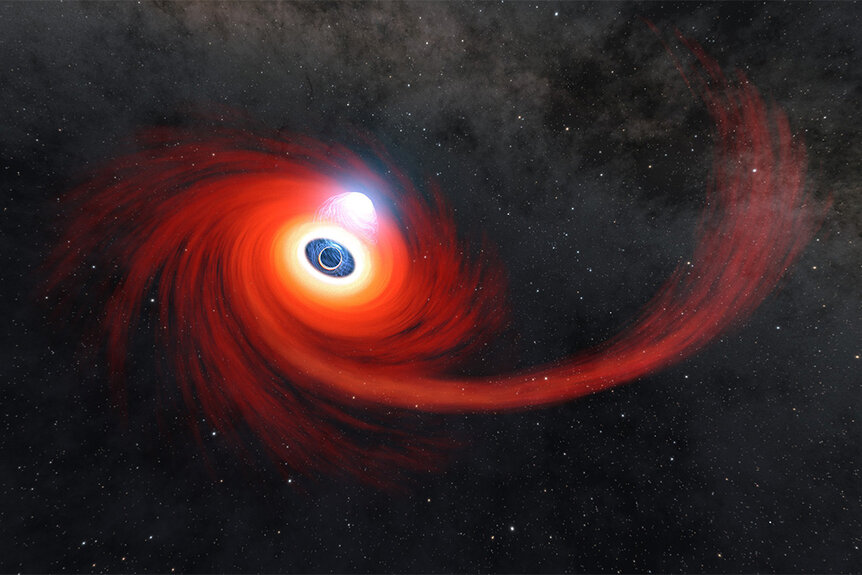Create a free profile to get unlimited access to exclusive videos, sweepstakes, and more!
"Scary Barbie" Black Hole Slurps Up a Star Like Spaghetti
A cosmic kiss of death stronger than Oppenheimer and Barbie combined.
When Oppenheimer and Barbie hit theaters at the same time, there was little reason to think they would compete with one another. They are very different movies intended for divergent audiences and yet they found a sort of bizarre companionship in the theaters, becoming the unexpected double feature dubbed "Barbenheimer."
Now, it turns out, the two cultural touchstones might have more in common than we realized. Thanks to a transient space object – an object which changes on short timescales of seconds, weeks, or years, as opposed to millions or billions of years – known as ZTF20abrbeie and dubbed "Scary Barbie" by astronomers, we now know that Barbie is packing the sort of power Oppenheimer could only dream of in the far reaches of deep space.
Scary Barbie Black Hole’s Appetite Lights Up the Sky
The object – a black hole in the process of gobbling up a star – wasn’t noticed when it was first observed back in 2020, but it was assigned a random designation. The ZTF at the beginning of its name refers to the Zwicky Transient Facility which made the observation, and the mishmash of letters at the end stuck out to astronomers. When combined with the raw power astronomers found when they took a closer look, the Scary Barbie moniker was born. Analysis of Scary Barbie was posted to the ArXiv preprint server and accepted for publication in The Astrophysical Journal Letters.
RELATED: Christopher Nolan's Oppenheimer Coming Home with 3 Hours of Bonus Features
“It's absurd. If you take a typical supernova and multiply it a thousand times, we're still not at how bright this is – and supernovas are among the most luminous objects in the sky. This is the most energetic phenomenon I have ever encountered,” said Danny Milisavljevic, an assistant professor of physics and astronomy in Purdue University’s College of Science, in a statement.
Despite the incredible energy on display, it wasn’t noticed at first because it’s far away and in a part of the sky that doesn’t get as much attention. It might have gone unnoticed a lot longer if not for a machine learning algorithm set loose on archival data. Researchers used the Recommender Engine For Intelligent Transient Tracking (REFITT) to do a first pass on the back catalog of astronomical observations and highlight candidate objects that look the most promising for additional analysis.
Once it was identified, the team was able to look for observations from other telescopes to start building a picture of what’s going on. When all the data came together, astronomers realized they were seeing a black hole rip a star to shreds.
“We think a very supermassive black hole pulled in a star and ripped it apart. The forces around a black hole, called tidal disruption, pull other objects apart in a process called ‘spaghettification.’ We think that’s what happened, but on extreme time scales: The most massive of black holes ripping apart a massive star. The duration is unlike anything we’ve ever seen before, and it produced the most luminous transient in the universe,” said Bhagya Subrayan, one of the study’s authors.
RELATED: Christopher Nolan's Oppenheimer Overtakes Bohemian Rhapsody as Highest-Grossing Biopic Ever
In addition to being brighter and more energetic than any transient object ever before discovered, Scary Barbie has demonstrated unusual staying power. Most of its peers fade out over the course of weeks or months but Scary Barbie has been going strong for more than two years. However, astronomers say the actual unspooling of the unfortunate prey star likely happened on a much shorter timescale. It appears to have played out more slowly from our perspective because the light got stretched out on its way from there to here. When we try to watch cosmic home movies like this one, relativity has a tendency to play fast and loose with the frame rate.
The identification of Scary Barbie is only the latest in a growing list of wins for machine learning in astronomy. Algorithms are increasingly doing the legwork of tromping through the uncharted swamps of archival astronomical data and lighting waypoints for human scientists along the way. Scary Barbie might have languished in data limbo for decades yet if not for a digital mole scouting the way.
Relive one half of the theatrical powerhouse that was Barbenheimer with Oppenheimer’s at-home release November 24.































